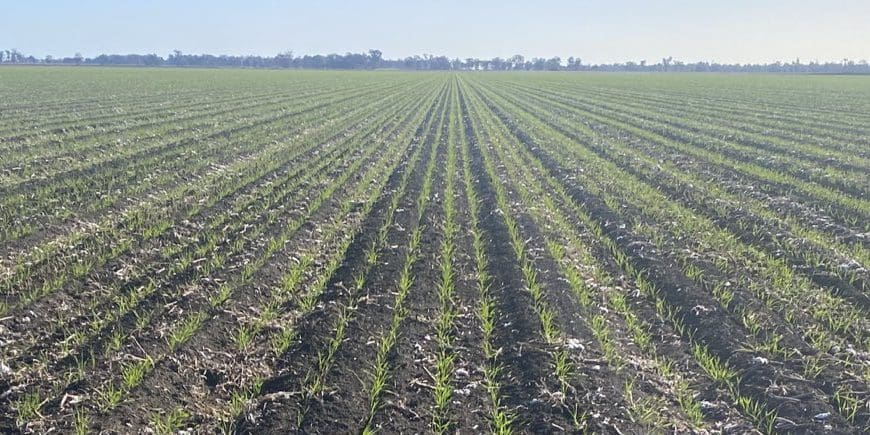
This wheat crop in the Narrabri district of northern NSW is in good stead, despite the dry season. Photo: Matt Norrie
WHEAT and barley prices have firmed by up to $15 per tonne in the past week in the northern market based on a lack of grower selling, and dropped $5-$10/t in the south as growers factor in what for most are good to ideal new-crop conditions.
While much of southern Australia had another week of showery weather, crops in northern New South Wales missed out on anything more than a few millimetres of rain.
| Today | July 6 | New crop | |
| Barley Downs | $425 | $420 | NQ |
| SFW wheat Downs | $435 | $420 | NQ |
| Sorghum Downs | $390 | $392 | NQ |
| Barley Melbourne | $335 | $345 | $335 |
| ASW Melbourne | $380 | $390 | NQ |
| SFW Melbourne | $380 | $385 | NQ |
Table 1: Indicative prices in Australian dollars per tonne.
North
Traders are reporting boat barley arriving from southern Australia was last traded at $432/t delivered Downs.
“Up here, growers not selling; come the new financial year, they’re not jumping out but there’s a lot of wheat and barley coming up from southern NSW,” one trader said.
While barley has been coming up for some weeks on trucks from southern NSW, wheat is now pricing north too.
“Northern NSW is patchy, and the market’s not trading a lot,” another trader said.
“Growers are being cautious and conservative, and El Niño is pressing the buttons at the grower level.
“Farmers need to keep their wits about them.
“If northern NSW conditions continue to disappoint, prices will rally, but prices in the southern grainbelt can’t go silly; crop conditions there are good to excellent.”
South
Barley from southern NSW continues to move north by road into feedlots on the Western Downs of southern Qld, and the drawing arc is moving south as on-farm values fall to around $275/t, down roughly $50/t since May.
In the southern market, growers and traders are proving more willing than those in the north to sell feed-type wheat and barley as export avenues dwindle in the face of Northern Hemisphere new-crop competition.
Those growers who have booked or taken delivery of urea are top-dressing crops to maximise yield potential, and some in the southern Riverina particularly are flying it on because of the boggy conditions.
“A lot of people are saying: ‘If this is El Niño, bring it on’,” Peters Commodities trader Peter Gerhardy said.
“Everyone’s looking for two or three weeks of fine weather.”
Trade selling appears to be generating more volume than grower selling, which has increased a little for those looking to make some space for what looks like another big crop.
“The problem we’ve got is the domestic market is the only outlet, and consumers have cover for July-August.”
Another trader said while El Niño may well be asserting itself in the northern market, growers in the south may be forced to meet the market at lower levels.
“The prevailing price in the eastern Australian cropping belt is above export parity and has been for some time.”
However, growers who are convinced El Niño will bite eastern Australia’s production prospects could well hold old-crop into early next year.
“Their balance sheets are strong and their ability to store is sound.”
Grain Central: Get our free news straight to your inbox – Click here

HAVE YOUR SAY